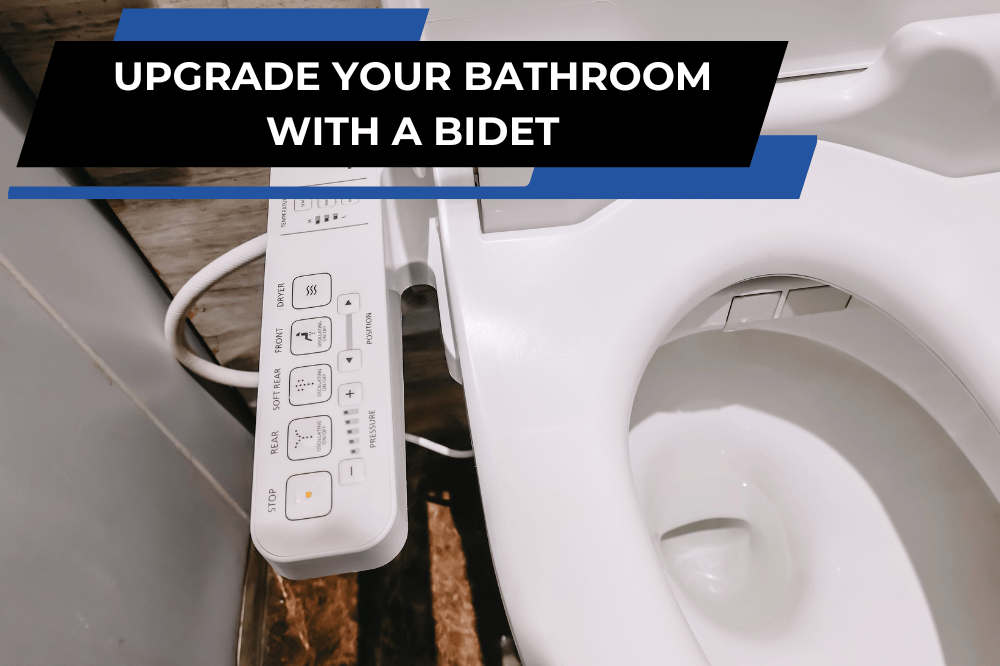What is a Bidet?
If you’ve been considering upgrading your bathroom, you might have wondered about the plumbing requirements for a bidet.
A bidet is a bathroom fixture designed to wash your private areas with water, offering a more hygienic alternative to toilet paper.
Bidets are gaining popularity for their health benefits, environmental impact, and overall comfort.
This guide will walk you through everything you need to know about installing a bidet toilet, including the various types of bidets and the plumbing requirements for each.
Benefits of Installing a Bidet
Improved Hygiene
One of the primary benefits of a bidet is improved hygiene. Unlike toilet paper, which can leave residue and bacteria behind, a bidet provides a thorough cleaning with water.
This can reduce the risk of infections and irritation, making it a healthier option for many people. For those with sensitive skin or certain medical conditions, bidets can be especially beneficial.
Environmental Impact
Using a bidet can significantly reduce your reliance on toilet paper. This not only saves trees but also reduces the energy and water used in the production and transportation of toilet paper.
In the long run, this can contribute to a more sustainable lifestyle. Additionally, less toilet paper usage means fewer clogs and plumbing issues, which can save homeowners time and money on maintenance.
Comfort and Health
Bidets are gentle on sensitive skin, making them ideal for people with conditions like hemorrhoids or irritable bowel syndrome. They are also beneficial for postpartum care, providing a soothing and hygienic way to clean.
The warm water feature, available on many modern bidets, adds an extra layer of comfort, making the cleaning process more pleasant.
Cost-Effectiveness
Although the initial investment in a bidet can be higher than buying toilet paper, the savings over time can be substantial.
By reducing your toilet paper usage, you’ll save money and reduce waste. High-quality bidet models also tend to have a long lifespan, making them a worthwhile investment for your home.
User-Friendly Features
Modern bidets come with a variety of user-friendly features such as warm water, adjustable spray settings, and air drying.
These features make using a bidet a luxurious and convenient experience. Some models also come with remote controls, night lights, and deodorizing functions, enhancing the overall bathroom experience.
Types of Bidets
Standalone Bidets
Standalone bidets are separate fixtures installed next to the toilet. They require both hot and cold water supply lines and a dedicated drain similar to a sink, typically a P-trap.
Standalone bidets also require adequate bathroom space for installation. These bidets often come with various spray settings and temperature controls, offering a customizable cleaning experience.
Bidet Toilet Combos
Bidet toilet combos integrate the bidet into the toilet design. They usually only require a cold water supply because the unit heats the water itself.
These combos also need an electrical outlet for features like heated water, a heated seat, and air drying.
Installing a bidet toilet combo typically involves both plumbing and electrical work. These units are highly convenient and often come with advanced features such as automatic lid opening and closing, multiple spray patterns, and personalized user settings.
Bidet Toilet Seats
Bidet toilet seats attach to your existing toilet. They connect to the existing toilet’s cold water line and require an electrical outlet for advanced features.
These seats are generally easy to install, often making them a DIY project. Despite their simplicity, many bidet seats come equipped with features like adjustable water temperature, oscillating spray, and built-in dryers, making them a cost-effective upgrade.
Plumbing Requirements for Different Types of Bidets
Understanding the plumbing requirements for a bidet is essential for a successful installation. Each type of bidet has unique requirements that homeowners need to consider.
Standalone Bidets
Standalone bidets need both hot and cold water supply lines. They also require a dedicated drain similar to a sink. Adequate bathroom space is necessary for their installation.
It’s essential to ensure that the hot and cold water lines are correctly installed and that the drain is appropriately connected to avoid leaks and potential water damage.
Bidet Toilet Combos
These combos typically need a cold water supply line and an electrical outlet. The unit heats the water itself, making the installation process more straightforward.
However, you might still need a professional plumber and electrician to ensure everything is installed correctly.
Ensuring proper electrical connections is crucial to safely operate the heating elements and other electrical features.
Bidet Toilet Seats
Bidet toilet seats are the easiest to install. They connect to the existing cold water line of your toilet and require an electrical outlet for advanced features. This type of bidet can often be installed without professional help. However, it’s important to make sure that the water connection is secure and that the electrical outlet is GFCI protected to prevent electrical hazards.
Step-by-Step Guide to Installing a Bidet Toilet Seat
Installing a bidet toilet seat is a relatively simple process that you can often do yourself. Here’s a step-by-step guide:
Turn Off Water Supply
First, locate and turn off the water supply to your toilet. This is usually found behind the toilet near the floor.
Remove Toilet Seat
Next, remove the existing toilet seat by unscrewing the bolts that hold it in place.
Install T-Valve
Attach a T-valve to the toilet’s fill valve. This valve will split the water supply between the toilet tank and the bidet seat.
Ensure the T-valve is properly tightened to prevent any leaks.
Connect Water Hose
Connect the water hose from the T-valve to the bidet seat. Make sure the connections are tight to avoid any leaks.
It’s a good idea to use plumber’s tape on the threads to ensure a watertight seal.
Install Bidet Seat
Mount the bidet seat on the toilet and secure it using the bolts provided. Ensure the seat is firmly in place and aligned correctly.
Connect Electrical Supply
If your bidet seat has electrical features, plug it into a nearby GFCI outlet. Make sure the power cord is safely routed and does not pose a tripping hazard.
Test the Bidet
Turn the water supply back on and test the bidet to ensure everything works correctly.
Adjust the settings as needed to find the most comfortable experience.
Check for any leaks around the connections and ensure that the electrical components are functioning properly.
Considerations for Professional Installation
While some bidet installations can be DIY projects, there are times when professional help is recommended.
Permits and Codes
Before starting your installation, check local building codes and whether permits are needed. This is especially important for standalone bidets and bidet toilet combos that require more extensive plumbing and electrical work.
Ensuring compliance with local codes will prevent any legal issues and ensure the installation is safe and reliable.
Professional Plumber
For complex installations, such as standalone bidets and bidet toilet combos, hiring a professional plumber is advisable.
A plumber can ensure that all connections are secure and that the installation meets local codes. They can also handle any unforeseen issues that may arise during installation, providing peace of mind that the job is done correctly.
Electrical Work
If you need to install an electrical outlet near your toilet, consider hiring an electrician. This ensures that the outlet is safely installed and meets all electrical codes.
Proper electrical installation is crucial to avoid any risks of electrical fires or malfunctions.
Conclusion
Bidets offer numerous benefits, from improved hygiene and comfort to environmental sustainability and cost savings.
Understanding the plumbing requirements for a bidet is crucial for a successful installation.
Whether you opt for a standalone bidet, a bidet toilet combo, or a bidet toilet seat, knowing the necessary plumbing setup will help you make an informed decision and ensure a smooth installation process.
Plumbing Installation Services with True Service Plumbing
Thinking about installing a bidet or similar plumbing installation in Toronto or the GTA? True Service Plumbing is your go-to expert for all your plumbing installation needs, serving both commercial and residential customers.
Our licensed professionals ensure a seamless installation, whether you’re upgrading your bathroom or adding a new fixture.
Unsure about the plumbing requirements for a bidet? Our team will guide you through every step, ensuring your bidet is installed correctly and efficiently, minimizing any disruption to your home or business.
Ready to upgrade your bathroom experience today? Don’t wait — reach out to True Service Plumbing now for a free consultation.
Quality Care, Quality Service — Just leave the wet stuff to us!


